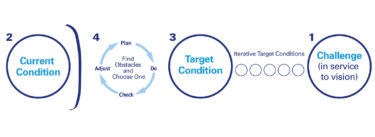Dear Gemba Coach,
How is standardized work different from the Taylorist one best way?
Umm… I’ll give you a typical lean answer on this one: it depends. It depends on what? Your outlook. How can your outlook change what a thing is? Well, it depends again. It depends whether you’re trying to implement lean or trying to learn lean thinking. It depends whether you’re seeking static optimization or dynamic gains.
Frederick Taylor’s one-best-way idea was in equal parts common sense and revolutionary. He thought of studying how work varied from person to person, picking the most efficient worker, breaking down how he worked in work elements, codifying it and then teaching all other workers to monkey see, monkey do. On the one hand this first gave tremendous productivity increases to any manager who did so (and Taylor insisted some of these productivity gains should be shared with the workers through higher wages), on the other hand no one likes to be told how to work and this approach created a lot of resistance, resistance that echoes more than a century later.
Standardized work is the sequence of movements one should follow to master a task. It’s not so much a process as a skill – a way to do things. Standardized work can thus either be seen as a way to force static efficiency by getting all workers to follow the standardized way – reversing it to Taylor’s one-best-way – or as a way to seek dynamic gains by treating it as a basis for improvement.
For instance, if the worker has only a general knowledge of the task, she’s likely to get into her own work habits and there are no reason to think this will be particularly helpful in terms of safety (some work habits can be dangerous), quality (check points might be ignored) or productivity (lack of movement fluidity). In this case, the first task is to catch-up to the best known way, and there is nothing else but learning the standardized work way and trying to apply it as well as we can. In this case, the best way we know.
But say that all workers have been trained to standardized work and you want to go further? On the gemba at a Toyota plant I remember being shown a case where a taller than usual operator struggled with a standard position to correctly place a windshield. In this case, rather than try and fix the one-best-way, the team leader was taught to discuss and observe with the team member and figure out what the difficulty really was. Beyond basic skills, the discussion entered into specific skills. As a result, both the physical environment and the movement for this specific team member was improved, which then led to a kaizen suggestion that improved the operation for all operators.
One Best Way
If you are in a below average situation, it makes sense to tread standardized work as a “one-best-way” catch-up tool: first learn standardized work. But if most of your guys already know standardized work, then SW becomes a basis for improvement, not a rule to apply. On the gemba, standardized work sheets are visual control to check how the work cycle is done, not for compliance but for understanding: discussing every case where the movement differs from the SW sheet and wonder why? Why? Why? In some cases the SW sheet is amended, in others the team member has to learn a new skill. If we’re lucky, someone comes out with a suggestion for further kaizen.
The confusion mostly arises from middle-managers who will not take into account team members as individuals, with their individual strengths and weaknesses, skills, body shape and specific obstacles to deal with. In lean’s ideal of “respect”, the frontline’s manager’s job is clearly to support on-goingly team members in their understanding and mastering of standardized work, and to do so in the constant improvement of standardized work, change point by change point. As Taiichi Ohno once wrote: “standards should not be forced down from above but rather set by production workers themselves.” Do you practice your Taiichi?






